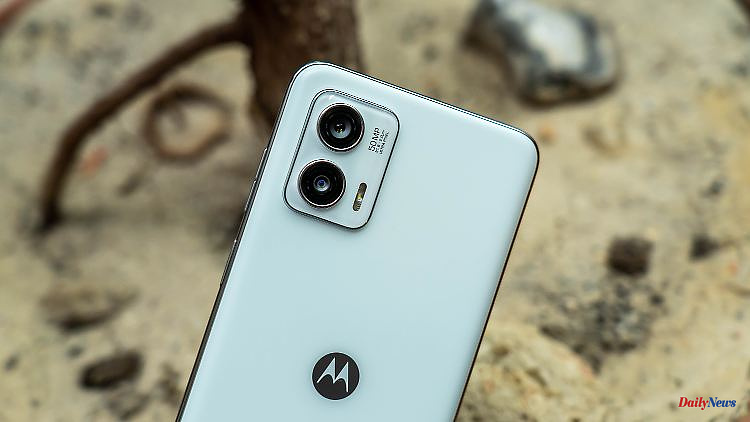With the Moto G73, Motorola wants to attract buyers in the hotly contested smartphone market in the affordable mid-range. In the practical test, the device has to show whether it has what it takes or whether the price of 300 euros is still too high.
Although the Mobile World Congress (MWC) is currently taking place in Barcelona, most well-known manufacturers are now refraining from celebrating major smartphone premieres there, as they did in previous years. Instead, they present new devices at their own events or simply send them into the race with a press release. Motorola also presented three new products for the entry-level and mid-range before the trade fair. The 5G flagship of the trio is the Moto G73, which is said to cost just under 300 euros. ntv.de tested how attractive the offer is.
What you can't expect at this price point is an exceptional design. The Moto G73 looks like many other androids in this price range. The only thing that is striking is that it has a jack socket on the underside, which has become rare in the meantime. The device, which weighs just 181 grams and is 8.3 millimeters thin, is not waterproof either, but merely has a "water-repellent design".
The pleasantly matt back is not made of glass but of plastic. If you don't know it, you hardly feel it. In addition, plastic has the great advantage that it is unlikely to shatter if the device should fall on the ground. Nevertheless, Motorola includes a silicone case. Above all, it protects the display by enclosing the frame at the sensitive corners.
Despite having a vintage wide lip ("chin") at the bottom, the 6.4-inch LCD is a highlight of the Moto G73. It is sufficiently sharp with a pixel density of 405 ppi, can shine very brightly, delivers good contrasts and natural colors. In the settings, you can, among other things, adjust the color temperature to your personal taste or activate a "night light" with a reduced blue component.
Not quite as amazing as it was a year or two ago, but still not a matter of course in this price range, is the display's high refresh rate of 120 Hertz (Hz). Normally, however, it is at 60 Hz and only increases to 120 Hz for games or videos for a smoother display. A fingerprint sensor is not integrated into the screen. It sits at a comfortable height in the on/off switch and responds quickly and precisely.
The smartphone is powered by the Dimensity 930 chip from the Taiwanese manufacturer MediaTek, which is becoming increasingly popular in the middle class. The processor can access 8 gigabytes (GB) of RAM. In benchmark tests, the chip also performs well. But the Moto G73 is the best proof that that doesn't mean too much. Sure, complex 3D games embarrass the processor, but the device reacts quickly in everyday use and operation is always very smooth. That's what matters.
And what is much more important than big muscles: The Dimensity 930 is extremely economical with resources. Since the battery also has a high capacity of 5000 milliampere hours (mAh), the Moto G73 is a real endurance runner that can last for two days with moderate use. In a pinch, the battery can be charged very quickly with the included 30-watt power adapter.
The flash memory is 256 GB and can be expanded with microSD cards if no second SIM card takes up the slot. The operating system only occupies a slim 10 GB, since Motorola leaves Google's current Android 13 almost unchanged. Unfortunately, the device will only receive one update to Android 14, and the manufacturer only provides security updates for three years.
This saves him a lot of effort and money. However, users also have an outdated smartphone in their hands more quickly. It's not sustainable, but it's still common in this price segment. In the future, however, an update obligation of five years will apply in the EU, as long as they are technically unproblematic.
On the other hand, buyers in the cheap middle class no longer have to live with lousy snaps. You can't expect cameras like in $1000 smartphones either, but you can expect satisfactory or even good photos and videos. This is also the case with the Moto G73.
The device is equipped with a main camera that takes photos with up to 50 megapixels and has a large aperture of f/1.8. It is complemented by an 8 MP super wide-angle camera (f/2.2), which can also be used for macro shots.
The main camera produces appealing photos with good contrasts and beautiful, accurate colors in daylight. Her night shots are also impressive. One of the reasons for this is that four pixels are combined in automatic mode for better light output. The videos from the main camera don't look bad either. However, it does not master 4K, with Full HD you have the choice between 30 or 60 frames per second (fps).
In good light, you can also do something with the super wide-angle camera, although it shows significantly fewer details than the main camera due to the low resolution. At night it produces too much color noise to be useful. Macro shots are okay in bright light. However, you get better results if you select appropriate image sections for photos taken with the main camera.
Overall, the Motorola Moto G73 is a smartphone that should satisfy many users who are looking for a good and cheap smartphone. In view of the general cost increases, other manufacturers will hardly be able to bring the corresponding hardware onto the market much more cheaply this year.
However, the competition in the lower middle class is fierce and the starting prices will not last long. For example, the Moto G82, which is about six months old and better equipped, came out for 330 euros and is now available from as little as 260 euros. So if you can, just wait a little longer.












